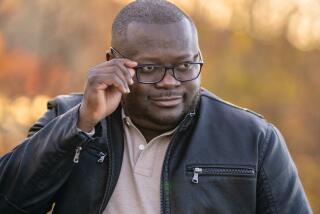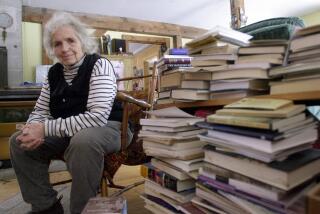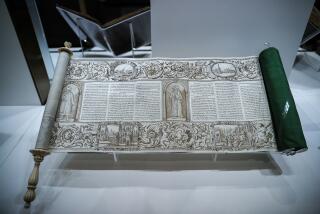The hard-eyed witness
As issues of war and peace, justice and vengeance currently tear our hearts, journalist Ruth Gruber gives us the benefit of wise perspective, deep concern in the second volume of her autobiography, âInside of Time: My Journey from Alaska to Israel.â Gruber has always been fiercely independent and powerfully talented. Born in 1911 in the âshtetl of Williamsburg, Brooklyn,â she was an adventurous rebel who defied tradition, challenged authority and confronted danger. She has lived a marvelous life, in large part fighting for justice on behalf of World War II refugees.
The first volume of her memoirs, âAhead of Time: My Early Years as a Foreign Correspondent,â detailed her early triumphs and struggles. She graduated from high school at 15, from New York University at 18. She earned a masterâs degree in German literature from the University of Wisconsin. She then completed a pioneering dissertation on Virginia Woolf at the University of Cologne, and at 20 became famous as the youngest PhD in the world. It was 1932, Hitlerism was on the rise, the Depression raged and Gruber could not get a teaching position.
She became a journalist and never looked back. Leading newspapers competed for her stories, and she was sent where no foreign correspondents had ever gone, including the Soviet Arctic and the gulag. She returned to Hitlerâs Germany and met Jews who were eager to leave but were blocked by harsh immigration barriers, including the bitter U.S. policy of delay and denial.
As a photojournalist, she was mentored by the best. Photographer Edward Steichen told her: âThink with your heart. Take pictures with your heart.â Every picture Gruber took, every word she wrote, every detail, was from the heart. The second volume of her memoir opens with her 1941 assignment to Alaska for a New York Herald Tribune series -- altered when Franklin D. Rooseveltâs secretary of the Interior Harold Ickes hired her to do reports for the U.S. government. He was inspired by her 1939 book, âI Went to the Soviet Arctic.â Alaska, after all, was the shortest route to Asia; at the Bering Strait only 55 miles from Russia. Gruberâs adventures in Alaska are fascinating and painful. The areaâs Inuits and Aleuts taught her how to live âinside of timeâ and record the realities of everything she witnessed. From her protests against tribal poverty and the humiliations of segregation in the military to her stand against environmental plunder, such as the seal killings of the Pribilof Islands, to the challenges she faced in a contemptuous macho culture in Alaska, her chronicle is written without bitterness, although she does name names.
The most urgent chapters involve Gruberâs efforts on behalf of refugees during and after the war. Today, Gruber is best known to popular audiences as the woman played by Natasha Richardson in the CBS miniseries âHaven,â based on her 1983 book. In 1944, while â[Adolf] Eichmann was in Hungary selecting 550,000 Jews for death in Auschwitz,â Gruber had an epiphany aboard the Army troop transport Henry Gibbins with refugees bound for a makeshift sanctuary at an Army outpost in Oswego, N.Y.
âStanding alone on the blacked-out deck ... I was trembling with the discovery that from this moment on my life would be forever bound with rescue and survival. I would use words and images, my typewriter and my cameras as my tools. I had to live the story to write it, and
After the war, opposition to refugees increased. Congress wanted those in Oswego returned immediately. Panic spread. With no place to go, the Jews who survived Nazi camps continued to languish. Gruber appealed to Secretary of the Treasury Henry Morgenthau Jr., who had done so much to create the War Refugee Board in 1944. Now he was uninterested.
Evidently, Morgenthau had promised Roosevelt that the refugees would be returned to their homelands as soon as the war ended: âI cannot sleep with my conscience if I go back on my promise to the dead president.â After pressure from Ickes and Gruber, President Truman went against the recommendations of the State and Justice departments. The Oswego refugees were safe.
From 1946 to 1948, Gruber traveled throughout Europe and the Middle East as a journalist, covering the Anglo-American Committee of Inquiry and the U.N. Special Committee on Palestine (UNSCOP). Truman asked Britainâs prime minister to open Palestine to 100,000 displaced persons. Britain refused. Gruberâs description of these negotiations, the regional tensions, the stunning needs, the layers of suffering do much to explain the ongoing agony of this divided, tormented land.
Unwanted by America, dispossessed in Europe, virtually all the survivors still in camps wanted to go to Palestine. But Britain closed the doors. Gruber was overwhelmed by the misery of the people she interviewed, and astonished by British brutality. She attended the Nuremberg trials of Nazi officials; she feared âmass suicideâ among the refugees. Anti-Jewish hatred soared throughout Europe, with propaganda and rumors that America was âsending German Jews to govern Germany and Austria in a military government.â In Vienna, Gruber, an assimilated secular American Jew, felt Jewish in an entirely new way: âI was riddled with guilt and haunted by the thought of what we might have done to have prevented some of the slaughter.â
Then she journeyed to Cairo, Baghdad and Jerusalem. The British patrolled Jerusalem in tanks; nobody walked freely. Chaim Weizmann protested on behalf of the Jewish community: âIt had become a prison, a walled-in city like the Warsaw ghetto.â Gruberâs sketches of David Ben-Gurion, Israelâs most prophetic leader, âa passionate visionary,â and Golda Meir, tough, hard-working, dedicated, are compelling.
But her descriptions of British abuse, without irony or pause, in this moment are curious. The British banned music from the shores of Galilee. British soldiers routinely stopped cars driven by Jews. She was told, âYou never know what to expect....They can pull you out of your car, lock you up, no charges, no trial, and youâre in jail for a couple of months, or a couple of years.â
In Palestine, Gruber met two cousins from Poland. On a kibbutz in the northern Emek region, she learned how everyone in her motherâs shtetl in the Wolyn province was murdered. Everyone, all ages, beaten, stripped, shot, then shoveled into the river. She was more determined than ever to have an impact: âI wanted my words and pictures to shake my readers.â Gruber wrote in the article âPalestine Today Is Ireland of 1921â: âThe fierce hatred of the British, the concentration camp atmosphere, the destruction of civil liberties, the growth of a peopleâs army -- the same social and political explosives which made Ireland the tinderbox of the last postwar period, make Palestine the time bomb of this one.â
The British Foreign Office was run by imperialists, âmen who think back through their grandfathers.â They recruited Nazis and fascists to patrol the streets of Jerusalem and Tel Aviv. British police trucks were chalked with swastikas and slogans, âKill the Jews.â
Finally, the U.N. created UNSCOP, without a British representative. Now there were differences among the Jews. Weizmann recommended a two-state solution: partition Palestine into a Jewish state and an Arab state. Others preferred one binational state, a secular democratic state of Jews and Arabs. At the time, Gruber wrote an article: âDivide the Land, and Let the People Grow.â
Gruber left UNSCOP meetings to cover the British attack against the ship Exodus 1947, which held 4,500 refugees. She described the outrages: Hundreds were wounded; a 16-year-old orphan who threw an orange at a British soldier was shot in the face. Then the waiting, the humiliation, the long sail back not to Cyprus but to Germany. Her brilliant photographs and dramatic book, âExodus 1947: The Ship That Launched a Nation,â caused an intense stir.
Finally, on May 14, 1948, Ben-Gurion announced the âworldâs newest Declaration of Independence.â Against State Department and military advice, Truman recognized Israel. Ben-Gurion envisioned âterrible bloodshed.â Within hours an Egyptian bomb fell on Tel Aviv. The Herald Tribuneâs Helen Rogers Reid sent Gruber back to the region to cover the war and the new migration. She protested the creation of wretched tent camps with nasty or no sanitation facilities. She interviewed women who cared for their babies in mud up to their knees. After meeting with Ben-Gurion, she sent him a report: âJews are running camps for Jews, and they seem to have learned nothing from their own tragedy.â The camps were soon replaced by decent housing, new towns.
Everywhere she went, Gruber bore witness, spoke bluntly, galvanized public opinion, inspired people to action. I eagerly await Ruth Gruberâs next installment, where she might help guide us through this tormented time when the brutal events in Israel, the Gaza Strip and the West Bank tear the heart out of her vision of the Promised Land. And so the wars go on until hope and respect are restored; until it becomes possible to divide the land and let the people grow.
More to Read
Sign up for our Book Club newsletter
Get the latest news, events and more from the Los Angeles Times Book Club, and help us get L.A. reading and talking.
You may occasionally receive promotional content from the Los Angeles Times.







